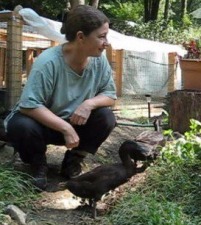Guerrilla Gardening Workshop at Laughing Dog Farm
| Yesterday my beloved and I traveled to Laughing Dog Farm in Gill, Massachusetts (U.S.) for a workshop on guerrilla gardening. I had wanted to meet Danny Botkin and Divya Shinn for some time, since learning about their work through social media. So when the announcement for the workshop appeared, I signed up right away. My beloved also wanted to see how they do it. And who can resist a visit to a farm named in honor of one of the most amazing creatures ever? Here is the url to explain: https://laughingdogfarm.com/n/27/Shebas-Eulogy---Spring-1988 And there are goats. When there are goats involved, I want to know more. Let´s get back to guerrilla gardening. According to Danny Botkin: “Guerrilla gardening might be described as a way of viewing food growing that is less planful and formulaic and more opportunistic, situational and intuitive. Such a farmer responds nimbly to unexpected windfalls and shifting circumstances, rather than reflexively following fixed protocols, plans or formulas. All farmers are called upon to improvise based on situational opportunity. However the guerrilla gardener tends to exploit unlikely “niches” and high-risk endeavors.” We arrived at the appointed time and were warmly greeted by Danny and Divya. We had an opportunity for a brief chat with another couple before the workshop began. There were a few couples, and the age range was from 20’s through 70’s, by my estimate. It was encouraging to have a group of friendly folk to learn with! Once everyone was assembled, Dan provided the formal welcome and overview of the farm, 3+ acres on a hilltop, two greenhouses, low tunnels, fruit and nut trees, barnyard (remember the goats?), barn, and house. One greenhouse has a rounded roof, the other a “gothic” roof with a sharper peak. Danny recommends the latter in snowy climates, as the snow does not build up on it, eliminating the risk of collapse from snow load. It was one of the many details he shared during the workshop. The low tunnels (miniature greenhouses) can be set up standalone as cold frames for season extension, or inside the greenhouses to protect more tender plants in the depths of winter. Danny and Divya make use of what is available at low or no cost in the area. They use their well-honed powers of observation to recognize opportunities in the form of materials that can be useful at the farm. This includes lumber, fencing, even plant materials. Danny goes to seed swaps, where, he says, generosity abounds. He always leaves with more than he expected. Regarding his approach to managing the plants and animals at the farm, Danny explains there is a fine balance between making efforts to revitalize what has been cast off, and making the “ruthless and painful choices to benefit the greater health/trajectory of the farm.” For example, does one take a little extra time to nurture a failing plant that may, if revived, produce a very good yield? Or just send it along to the goats to turn into manure, which will then go on to become compost and eventually part of the soil that nurtures all the life at Laughing Dog Farm? Divya and Danny also understand that they are not going to produce every single thing they need on site. They connect with others who can provide those things, and everyone benefits. Aside from the time well spent during the workshop explaining the principles that guide the day-to-day activities at the farm, Danny demonstrated some of the activities themselves. He emphasized the appropriate use of a number of types of mulch. We saw in the greenhouse where most of the workshop was held, just what that looks like. (The soil outside was covered by inches of snow, capped with a layer of ice, so we could not observe the outdoor mulch. ) He showed us spinach seedlings started in his greenhouse three weeks earlier, looking green and lively. He demonstrated his method of combining several kinds of seeds into a mix that is then sown thickly in starter pots, without watering. Yup. His experience in the conditions he grows in, have taught him that too much moisture has cost him more plant seedling loss than too little moisture. Growing in a greenhouse in winter differs significantly from growing outdoors in summer, of course. But it was a reality check to see that starting seeds in the greenhouse here was done without initial watering. Danny provided us with a list of 18 “Elements of Guerrilla Gardening,” including: Build incredible soil on-site with relentless sheet mulching. Fall in love with the “hardies.” Become a radical seed saver. Harvest everything, exploit the margins, “peck away,” suffer no waste. After the demonstrations and tour of the greenhouse, we feasted on some of the yield of the farm – roasted potatoes and chestnuts, dried apples and peaches, homemade sourdough bread and goat cheese. We continued our discussions, questions and answers as we noshed away. Danny and Divya were generous with their time, knowledge, wisdom, and the fruits of their labors. The environment was warm and welcoming, the pace was perfect. We covered quite a bit of ground in three short hours. It was a fine day, and the late winter sun was a kindness from nature. Keep an eye on Laughing Dog Farm’s educational offerings and if you can get there, please do. Danny and Divya are living it – living a Permaculture-inspired life, practicing the principles amid all the challenges presented by our current world. |
